Magmatic Processes at Euganean Hills (Veneto Volcanic Province, Italy): Clinopyroxene Investigation to Unravel Magmatic Interactions
Abstract
:1. Introduction
2. Geological and Volcanological Outlines
2.1. Evidence of Magmatic Interaction at Euganean Hills
2.2. Crystal-Chemistry of Clinopyroxene from Euganean Hills Volcanic Rocks
3. Materials and Methods
3.1. Sample Collection
3.2. Pyroxene Selections from Magmatic Enclaves
3.3. Single-Crystal X-ray Diffraction (SCXRD)
3.4. Electron Microprobe Data
3.5. Laser Ablation Inductively Coupled Plasma Mass Spectrometry
4. Results
4.1. Clinopyroxene Crystal-Chemistry
4.2. Clinopyroxene Structural Data
- (Al, Si)T = (Ca, Na)M2;
- (Fe, Ti, Mg)M1 = (Al, Si)T;
- (Ca)M2 = (Mg, Fe)M2.
5. Discussion
- Intrusive (and crystal mushes) enclaves;
- Volcanic enclaves.
5.1. Geobarometric Considerations
5.1.1. Geobarometry Based on the Structural Geometry of the Analyzed Clinopyroxenes
5.1.2. Geobarometry Based on the Clinopyroxene Geochemistry
5.1.3. Geobarometry Based on the Amphibole Geochemistry
6. Conclusions
- Clinopyroxene major and trace elements composition of host and volcanic enclaves pairs suggest similar parental magmas differing in small degrees of fractional crystallisation;
- Single-crystal clinopyroxene geobarometer based on crystal structure and geochemistry and amphibole geobarometer agree in the estimation of a pressure of crystallisation between 4.8–2.0 kbars;
- A complex system of magma chambers at intermediate to shallow crustal level can be inferred by using clinopyroxene and amphibole phenocrysts as toolkits. Here, mafic magmas accumulated, evolved by fractionation processes, and mixing occurred before eruption (Figure 9).
Author Contributions
Funding
Institutional Review Board Statement
Informed Consent Statement
Data Availability Statement
Acknowledgments
Conflicts of Interest
References
- Piccoli, G.; Sedea, R.; Bellati, R.; Di Lallo, E.; Medizza, F.; Girardi, A.; De Pieri, R.; De Vecchi, G.P.; Gregnanin, A.; Piccirillo, E.M.; et al. Note illustrative della carta geologica dei Colli Euganei alla scala 1:25,000. Mem. Ist. Geol. Mineral. Univ. Padova 1981, 34, 523–566. [Google Scholar]
- Beccaluva, L.; Bianchini, G.; Bonadiman, C.; Coltorti, M.; Milani, L.; Salvini, L.; Siena, F.; Tassinari, R. Intraplate lithospheric and sublithospheric components in the Adriatic domain: Nephelinite to tholeiite magma generation in the Paleogene Veneto Volcanic Province, Southern Alps. In Cenozoic Volcanism in the Mediterranean Area; Beccaluva, L., Bianchini, G., Wilson, M., Eds.; Special Paper of the Geological Society of America(GSA); GSA: Boulder, CO, USA, 2007; Volume 418, pp. 131–152. [Google Scholar]
- Borsi, S.; Ferrara, G.; Piccoli, G. Determinazioni col metodo K/Ar dell’età delle eruzioni euganee. Rend. Soc. It. Min. Petrol. 1969, 25, 27–34. [Google Scholar]
- Zantedeschi, C. New Rb-Sr radiometric data from Colli Euganei (North-Eastern Italy). Mem. Sci. Geol. 1994, 46, 17–22. [Google Scholar]
- De Vecchi, G.P.; Gregagnin, A.; Piccirillo, E.M. Tertiary volcanism in the Veneto: Magmatology, petrogenesis and geodynamic implications. Int. J. Earth Sci. 1976, 65, 701–710. [Google Scholar] [CrossRef]
- Bartoli, O.; Meli, S.; Bergomi, M.A.; Sassi, R.; Magaraci, D.; Liu, D.-Y. Geochemistry and Zircon U-Pb geochronology of magmatic enclaves in trachites from the Euganean Hills (NE, Italy): A further constraints on Oligocene magmatism in the eastern Southern Alps. Eur. J. Mineral. 2015, 27, 161–174. [Google Scholar] [CrossRef]
- Wass, S.Y. Multiple origins of clinopyroxenes in alkali basaltic rocks. Lithos 1979, 12, 115–132. [Google Scholar] [CrossRef]
- Nazzareni, S.; Molin, G.; Peccerillo, A.; Zanazzi, P.F. Volcanological implications of crystal-chemical variations in clinopyroxenes from Aeolian archipelago (south Tyrrhenian sea). Bull. Volcanol. 2001, 63, 73–82. [Google Scholar] [CrossRef]
- Nazzareni, S.; Skogby, H.; Zanazzi, P.F. Hydrogen content in clinopyroxene phenocrysts from Salina mafic lavas (Aeolian arc, Italy). Contrib. Mineral. Petrol. 2011, 162, 275–288. [Google Scholar] [CrossRef]
- Nazzareni, S.; Rossi, S.; Petrelli, M.; Caricchi, L. Architecture of the magmatic system in the Main Ethiopian Rift. In Dynamic Magma Evolution; Vetere, P., Ed.; Geophysical Monograph Series AGU-Willey: Hoboken, NJ, USA, 2020; Volume 254, pp. 133–151. [Google Scholar]
- Neave, D.A.; Putirka, K.D. A new clinopyroxene-liquid barometer, and implications for magma storage pressures under Icelandic rift zones. Am. Mineral. 2017, 102, 777–794. [Google Scholar] [CrossRef] [Green Version]
- Brizi, E.; Nazzareni, S.; Princivalle, F.; Zanazzi, P.F. Clinopyroxenes from mantle-related xenocrysts in alkaline basalts from Hannuoba (China): Augite-pigeonite exsolutions and their thermal significance. Contrib. Mineral. Petrol. 2003, 145, 578–584. [Google Scholar] [CrossRef]
- Perugini, D.; Busà, T.; Poli, G.; Nazzareni, S. The role of chaotic dynamics and flow fields in the development of disequilibrium textures in volcanic rocks. J. Petrol. 2003, 44, 733–756. [Google Scholar] [CrossRef]
- Ubide, T.; Mollo, S.; Zhao, J.; Nazzari, M.; Scarlato, P. Sector-zoned clinopyroxene as a recorder of magma history, eruption triggers, and ascent rates. Geochim. Cosmochim. Acta 2019, 251, 265–283. [Google Scholar] [CrossRef] [Green Version]
- Nazzareni, S.; Barbarossa, V.; Skogby, H.; Zanon, V.; Petrelli, M. Magma water content of Pico volcano (Azores islands, Portugal): A clinopyroxene perspective. Contrib. Mineral. Petrol. 2020, 175, 87. [Google Scholar] [CrossRef]
- Duda, A.; Schmincke, H.-U. Polybaric differentiation of alkali basaltic magmas: Evidence from green-core clinopyroxenes (Eifel, FRG). Contrib. Mineral. Petrol. 1985, 91, 340–353. [Google Scholar] [CrossRef]
- Bellieni, G.; Fioretti, A.M.; Marzoli, A.; Visonà, D. Permo- Paleogene magmatism in the eastern Alps. Rend. Fis. Acc. Lincei 2010, 21, 51–71. [Google Scholar] [CrossRef]
- De Vecchi, G.P.; Sedea, R. The Paleogene basalts of the Veneto Region (NE Italy). Mem. Ist. Sci. Geol. Università di Padova 1995, 47, 253–374. [Google Scholar]
- Brombin, V.; Bonadiman, C.; Jourdan, F.; Roghi, G.; Coltorti, M.; Webb, L.E.; Callegaro, S.; Bellieni, G.; De Vecchi, G.; Sedea, R.; et al. Intraplate magmatism at a convergent plate boundary: The case of the Cenozoic northern Adria magmatism. Earth-Sci. Rev. 2019, 192, 355–378. [Google Scholar] [CrossRef]
- Galassi, B.; Monese, A.; Ogniben, G.; Siena, F.; Vaccaro, C. Age and nature of lamprophyric dykes at Calceranica (Trento). Mineral. Petrog. Acta 1994, 37, 163–171. [Google Scholar]
- Visona‘, D.; Caironi, V.; Carraro, A.; Dallai, L.; Fioretti, A.M.; Fanning, M. Zircon megacrysts from basalts of the Venetian Volcanic Province (NE Italy): U–Pb ages, oxygen isotopes and REE data. Lithos 2007, 94, 168–180. [Google Scholar] [CrossRef]
- Bonadiman, C.; Coltorti, M.; Milani, L.; Salvini, L.; Siena, F.; Tassinari, R. Metasomatism in the lithospheric mantle and its relationships to magmatism in the Veneto Volcanic Province, Italy. Per. Mineral. 2001, 70, 333–357. [Google Scholar]
- Braga, R.; Morten, L.; Zanetti, A. Origin of a mica megacryst in an alkaline dyke from the Veneto Volcanic Province, Italy. Eur. J. Mineral. 2006, 18, 223–231. [Google Scholar] [CrossRef]
- Bianchini, G.; Beccaluva, L.; Siena, F. Post-collisional and intraplate Cenozoic volcanism in the rifted Apennines/Adriatic domain. Lithos 2008, 101, 125–140. [Google Scholar] [CrossRef]
- Milani, L.; Beccaluva, L.; Coltorti, M. Petrogenesis and evolution of the Euganean Magmatic Complex, Veneto region, north-east Italy. Eur. J. Mineral. 1999, 11, 379–399. [Google Scholar] [CrossRef]
- Macera, P.; Gasperini, D.; Ranalli, G.; Mahatsente, R. Slab detachment and mantle plume upwelling in subduction zones: An example from the Italian South-Eastern Alps. J. Geodyn. 2008, 45, 32–48. [Google Scholar] [CrossRef] [Green Version]
- Zampieri, D. Tertiary extension in the southern Trento Platform, southern Alps, Italy. Tectonics 1995, 14, 645–657. [Google Scholar] [CrossRef]
- Gasperini, D.; Bosch, D.; Braga, R.; Bondi, M.; Macera, P.; Morten, L. Ultramafic xenoliths from the Veneto Volcanic Province (Italy): Petrological and geochemical evidence for multiple metasomatism of the SE Alps mantle lithosphere. Geochem. J. 2006, 40, 377–404. [Google Scholar] [CrossRef] [Green Version]
- Cannatelli, C. Multi-stage metasomatism in the lithosphere beneath the Veneto Volcanic Province (VVP, Northern Italy). Mineral. Petrol. 2012, 104, 177–195. [Google Scholar] [CrossRef]
- Bartoli, O.; Meli, S.; Sassi, R.; Magaraci, D. Amphiboles and clinopyroxenes from Euganean (NE Italy) cumulus enclaves: Evidence of subduction-related melts below Adria microplate. Rend. Fis. Acc. Lincei 2013, 24, 151–161. [Google Scholar] [CrossRef]
- Le Maitre, R.W.; Bateman, P.; Dudek, A.; Keller, J.; Lameyre, J.; Le Bas, M.J.; Sabine, P.A.; Schmid, R.; Sorensen, H.; Streckeisen, A.; et al. A Classification of Igneous Rocks and Glossary of Terms: Recommendations of the International Union of Geological Sciences Subcommission on the Systematics of Igneous Rocks; Blackwell Scientific: Oxford, UK, 1989. [Google Scholar]
- Prosperini, N. Fenomeni di Interazione tra Magmi in Ambiente Effusivo: Studio Petrografico e Geochimico di Inclusi Magmatici. Ph.D. Thesis, University of Firenze and Perugia, Firenze, Italy, 1998. [Google Scholar]
- Sassi, R.; Mazzoli, C.; Spiess, R.; Cester, T. Towards a better understanding of the fibrolite problem: The effect of reaction overstepping and surface energy anisotropy. J. Petrol. 2004, 45, 1467–1479. [Google Scholar] [CrossRef]
- Sassi, R.; Cruciani, G.; Mazzoli, C.; Nodari, L.; Craven, J. Multiple titanium substitutions in biotites from high-grade metapelitic xenoliths (Euganean Hills, Italy): Complete crystal chemistry and appraisal of petrologic control. Am. Mineral. 2008, 93, 339–350. [Google Scholar] [CrossRef]
- Sassi, R.; Mazzoli, C.; Merle, R.; Brombin, V.; Chiaradia, M.; Dunkley, D.J.; Marzoli, A. HT–LP crustal syntectonic anatexis as a source of the Permian magmatism in the Eastern Southern Alps: Evidence from xenoliths in the Euganean trachytes (NE Italy). J. Geol. Soc. 2020, 177, 1211. [Google Scholar] [CrossRef]
- Germinario, L.; Hnchar, J.M.; Sassi, R.; Maritan, L.; Cossio, R.; Borghi, A.; Mazzoli, C. New petrographic and geochemical tracers for recognizing the provenance quarry of trachyte of the Euganean Hills, northeastern Italy. Geoarcheology 2018, 33, 430–452. [Google Scholar] [CrossRef]
- Carbonin, S.; Dal Negro, A.; Molin, G.M.; Munno, R.; Rossi, G.; Lirer, L.; Piccirillo, E.M. Crystal chemistry of Ca-rich pyroxenes from undersatured to oversatured trachytic rocks and their relatioships with pyroxenes from basalts. Lithos 1984, 17, 191–202. [Google Scholar] [CrossRef]
- De Pieri, R.; Molin, G. Trachyte pyroxnens in the Euganean Hills (North-eastern Italy). N. Jb. Miner. Abh. 1980, 138, 64–80. [Google Scholar]
- McDonough, W.F.; Sun, S.S. The Composition of the Earth. Chem. Geol. 1995, 120, 223–253. [Google Scholar] [CrossRef]
- Sheldrick, G.M. A short history of SHELX. Acta Cryst. 2008, A64, 112–122. [Google Scholar] [CrossRef] [Green Version]
- Robinson, K.; Gibbs, G.V.; Ribbe, P.H. Quadratic elongation; a quantitative measure of distortion in coordination polyhedra. Science 1971, 172, 567–570. [Google Scholar] [CrossRef]
- Nazzareni, S.; Molin, G.; Peccerillo, A.; Zanazzi, P.F. Structural and chemical variations in clinopyroxenes from the island of Alicudi (Aeolian Arc) and their implications for the conditions of crystallization. Eur. J. Mineral. 1998, 10, 291–300. [Google Scholar] [CrossRef]
- Paton, C.; Hellstrom, J.; Paul, B.; Woodhead, J.; Hergt, J. Iolite: Freeware for the visualisation and processing of mass spectrometric data. J. Anal. At. Spectrom. 2011, 26, 2508–2518. [Google Scholar] [CrossRef]
- Pearce, J.G.N.; Perkins, W.T.; Westgate, J.A.; Gorton, M.P.; Jackson, S.E.; Neal, C.R.; Chenery, S.P. A compilation of new and published major and trace element data for NIST SRM 610 and NIST SRM 612 glass reference materials. Geostand. Newsl. 1997, 21, 115–144. [Google Scholar] [CrossRef]
- Wilson, S.A. The Collection, Preparation, and Testing of USGS Reference Material BCR-2, 557 Columbia River, Basalt: USGS; Survey Open-File Report; USGS: Reston, VA, USA, 1997; 98p.
- Petrelli, M.; Morgavi, D.; Vetere, F.; Perugini, D. Elemental imaging and petro-volcanological applications of an improved Laser Ablation Inductively Coupled Quadrupole Plasma Mass Spectrometry. Per. Mineral. 2016, 85, 25–39. [Google Scholar]
- Petrelli, M.; Morgavi, D.; Vetere, F.; Perugini, D. High spatial resolution trace element determination of geological samples by laser ablation quadrupole plasma mass spectrometry: Implications for glass analysis in volcanic products. Geosci. J. 2016, 20, 851–863. [Google Scholar] [CrossRef] [Green Version]
- Dal Negro, A.; Carbonin, S.; Molin, G.M.; Cundari, A.; Piccirillo, E.M. Intracristalline cation distribution in natural clinpopyroxenes of tholeiitic, transitional, and alkaline basaltic rocks. In Advances in Physical Geochemistry; Saxena, S.K., Ed.; Springer: New York, NY, USA, 1982; Volume 2, pp. 117–150. [Google Scholar]
- Morgavi, D.; Arzilli, F.; Pritchard, C.; Perugini, D.; Mancini, L.; Larson, P.; Dingwell, D.B. The Grizzly Lake complex (Yellowstone Volcano, USA): Mixing between basalt and rhyolite unraveled by microanalysis and X-ray microtomography. Lithos 2016, 260, 457–474. [Google Scholar] [CrossRef] [Green Version]
- Perugini, D. The Mixing of Magmas. Field Evidence, Numerical Models, Experiments; Springer Nature Switzerland AG: Cham, Switzerland, 2021; p. 162. [Google Scholar]
- Jankovics, M.E.; Taracsák, Z.; Dobosi, G.; Embey-Isztin, A.; Batki, A.; Harangi, S.; Hauzenberger, C.A. Clinopyroxene with diverse origins in alkaline basalts from the western Pannonian Basin: Implications from trace element characteristics. Lithos 2016, 262, 120–134. [Google Scholar] [CrossRef]
- Villaseca, C.; Serrano, J.G.; Orejana, D. Pyroxenites and megacrysts from alkaline melts of the Calatrava Volcanic Field (Central Spain): Inferences from trace element geochemistry and Sr-Nd isotope composition. Front. Earth Sci. 2020, 8, 132. [Google Scholar] [CrossRef]
- Barton, M.; Bergen, V.M.J. Green clinopyroxenes and associated phases in a potassium-rich lava from the Leucite Hills, Wyoming. Contrib. Mineral. Petrol. 1981, 77, 101–114. [Google Scholar] [CrossRef]
- Pe-Piper, G. Zoned pyroxenes from shoshonite lavas of Lesbos, Greece: Inferences concerning shoshonite petrogenesis. J. Petrol. 1984, 25, 453–472. [Google Scholar] [CrossRef]
- Barton, M.; Varekamp, J.C.; Bergen, V.M.J. Complex zoning of clinopyroxenes in the lavas of Vulsini, Latium, Italy: Evidence for magma mixing. J. Volcanol. Geoth. Res. 1982, 14, 361–388. [Google Scholar] [CrossRef] [Green Version]
- Nimis, P. Clinopyroxene geobarometry of magmatic rocks. Part 2. Structural geobarometers for basic to acid, tholeiitic and mildly alkaline magmatic system. Contrib. Mineral. Petrol. 1999, 135, 62–74. [Google Scholar] [CrossRef]
- Putirka, K.D. Thermometers and barometers for volcanic systems. Rev. Mineral. Geochem. 2008, 69, 61–120. [Google Scholar] [CrossRef]
- Petrelli, M.; Caricchi, L.; Perugini, D. Machine Learning Thermo-Barometry: Application to Clinopyroxene-Bearing Magmas. J. Geophys. Res. Solid Earth 2020, 125, e2020JB020130. [Google Scholar] [CrossRef]
- Nimis, P.; Ulmer, P. Clinopyroxene geobarometry of magmatic rocks. 1. An expanded structural geobarometer for anhydrous and hydrous, basic and ultrabasic systems. Contrib. Mineral. Petrol. 1998, 133, 314–327. [Google Scholar] [CrossRef]
- Nazzareni, S.; Busà, T.; Cristofolini, R. Magmatic crystallisation of Cr-Al diopside and Al-Fe3+ diopside from the ancient alkaline basalts (Mt. Etna, Sicily). Eur. J. Mineral. 2003, 1305, 81–93. [Google Scholar] [CrossRef]
- Sack, R.O.; Ghiorso, M.S. Thermodynamics of multicomponent pyroxenes: III. Calibration of Fe2+(Mg)−1, TiAl2(MgSi2)−1, TiFe3+2 (MgSi2)−1, AlFe3+(MgSi)−1, NaAl(CaMg)−1, Al2(MgSi)−1 and Ca(Mg)−1 exchange reactions between pyroxenes and silicate melts. Contr. Mineral. Petrol. 1994, 118, 271–296. [Google Scholar] [CrossRef]
- Holland, T.; Blundy, J. Non-ideal interactions in calcic amphiboles and their bearing on amphibole-plagioclase thermo- metry. Contrib. Mineral. Petrol. 1994, 116, 433–447. [Google Scholar] [CrossRef]
- Anderson, J.L.; Smith, D.R. The effects of temperature and fO2 on the Al-in-hornblende barometer. Am. Mineral. 1995, 80, 549–559. [Google Scholar] [CrossRef]
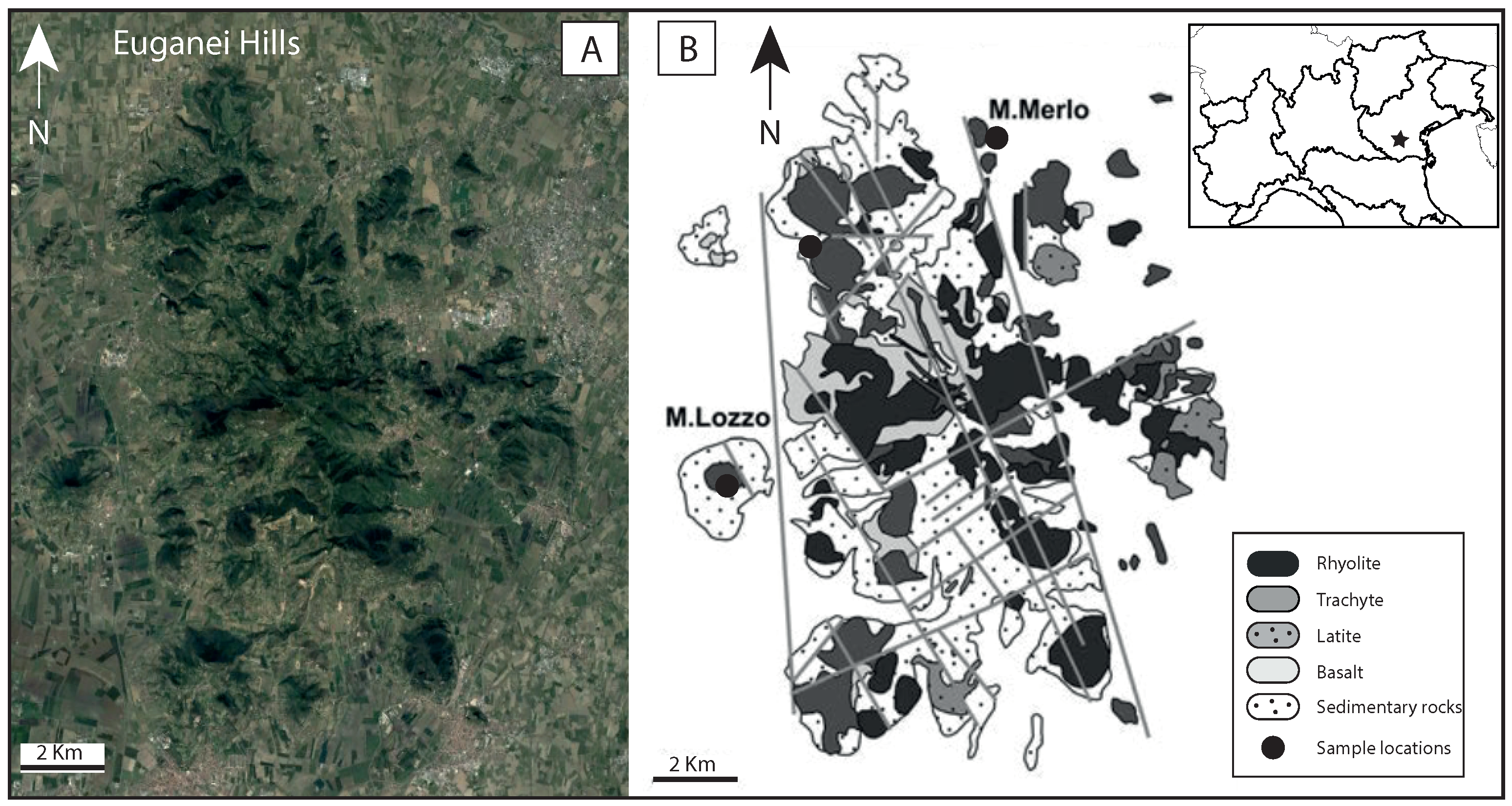
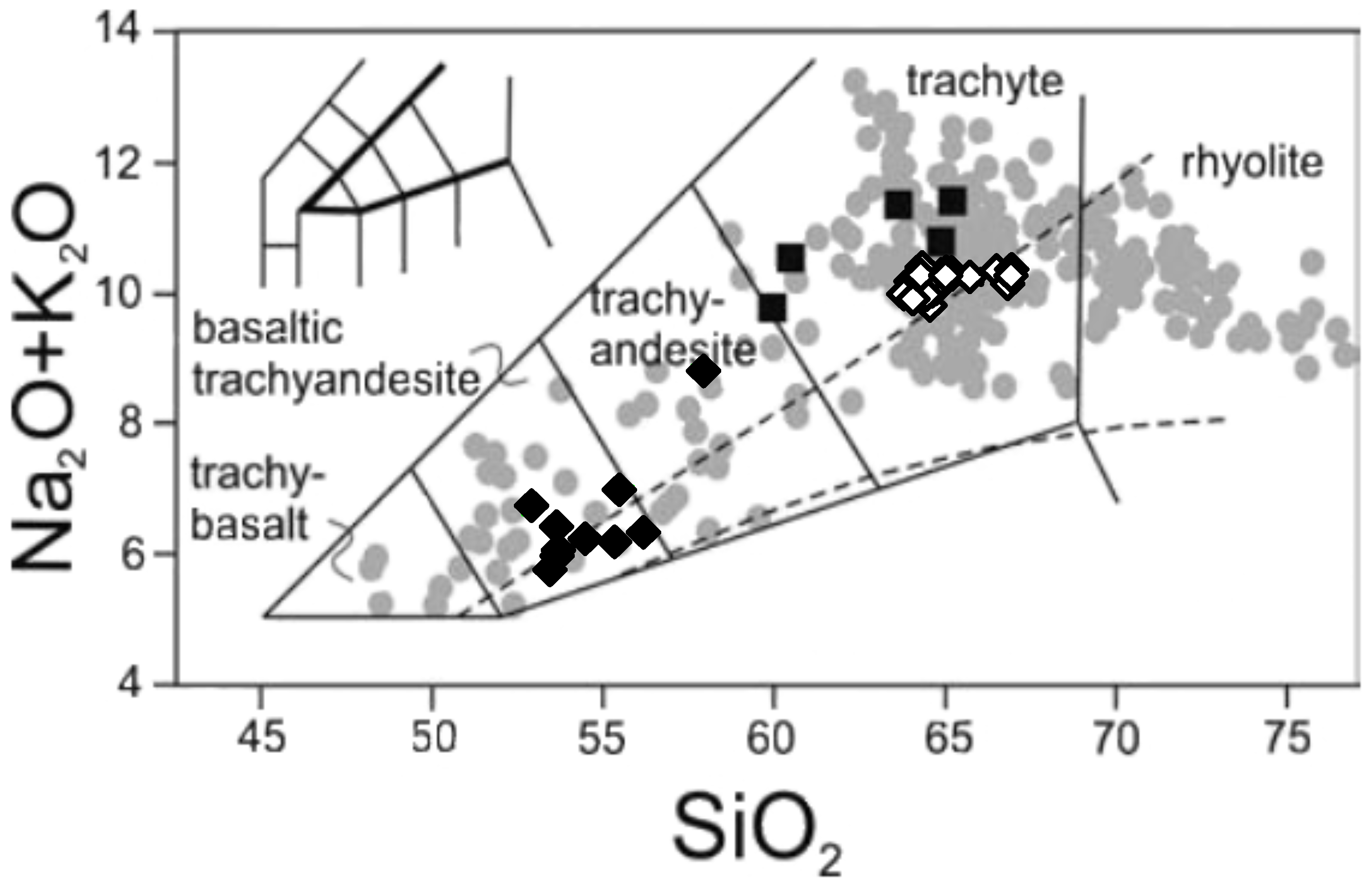
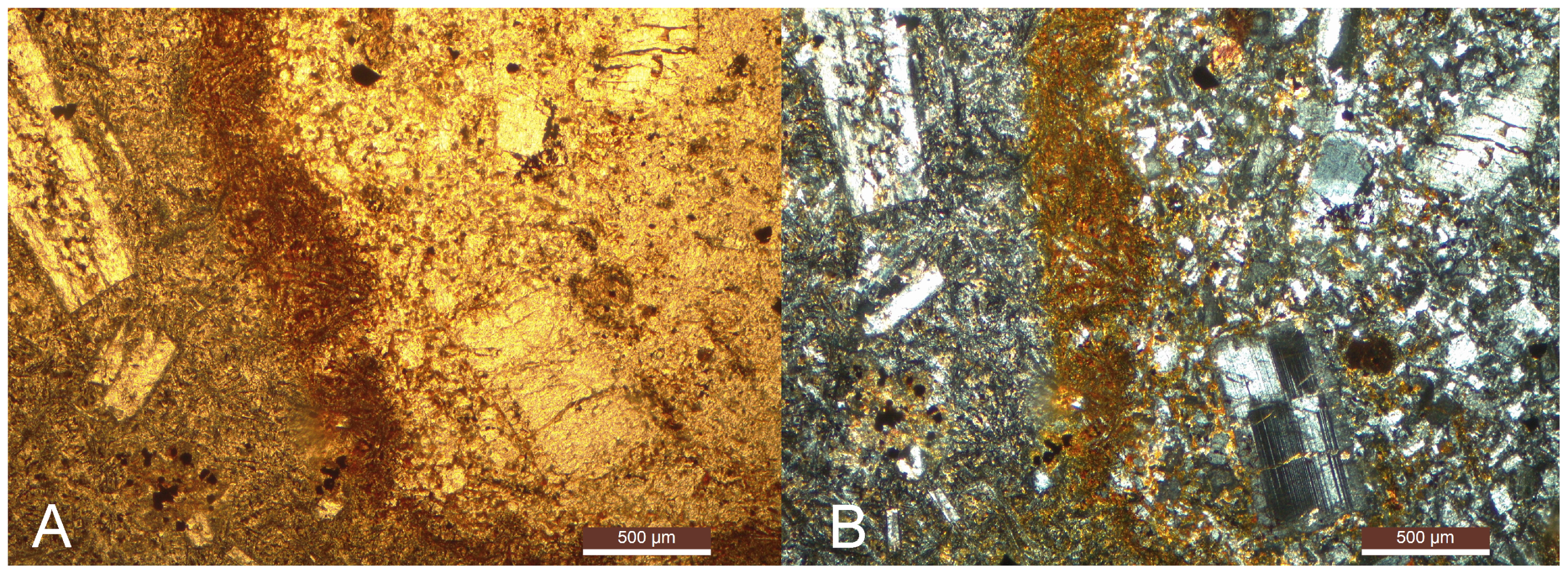
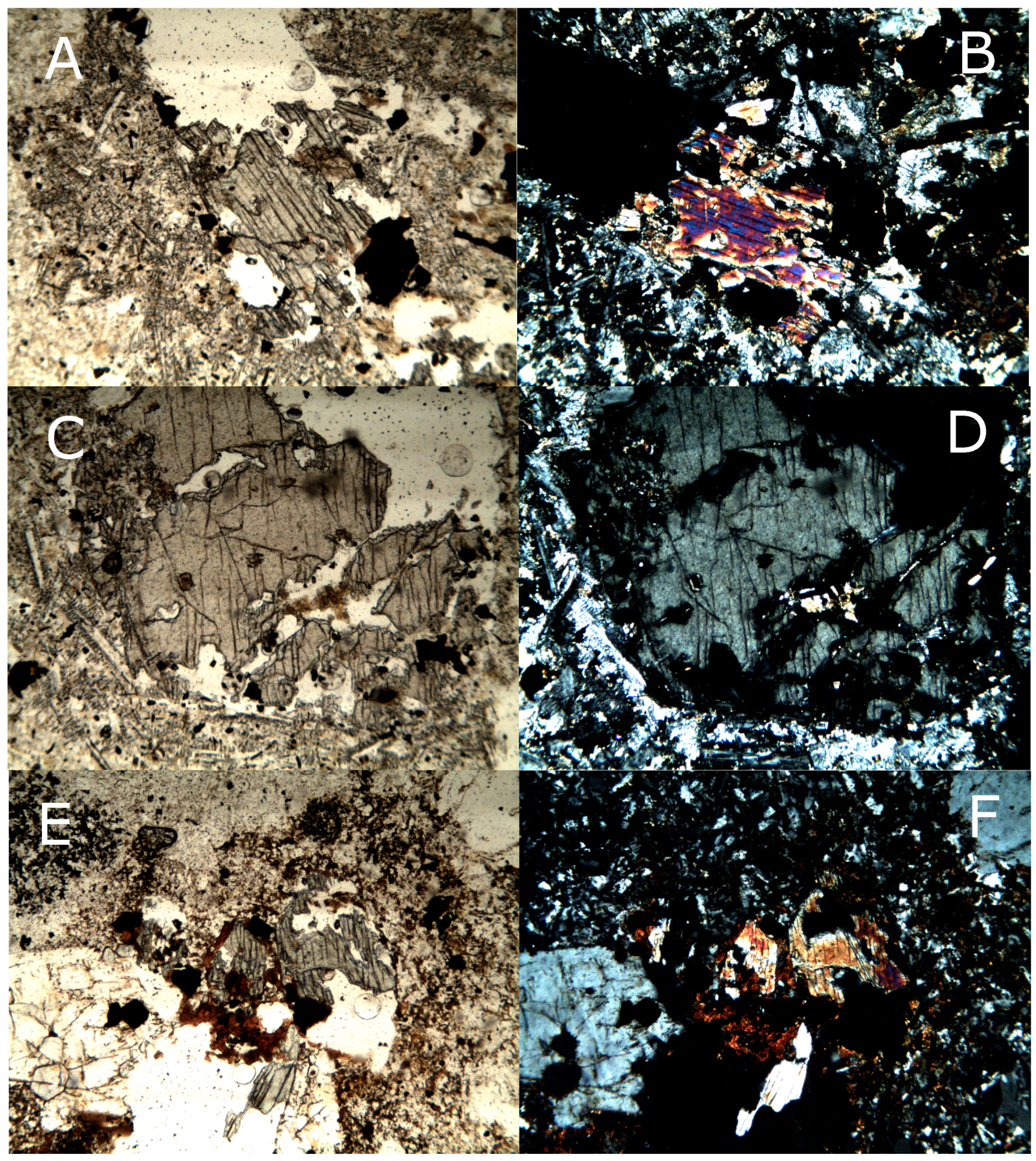
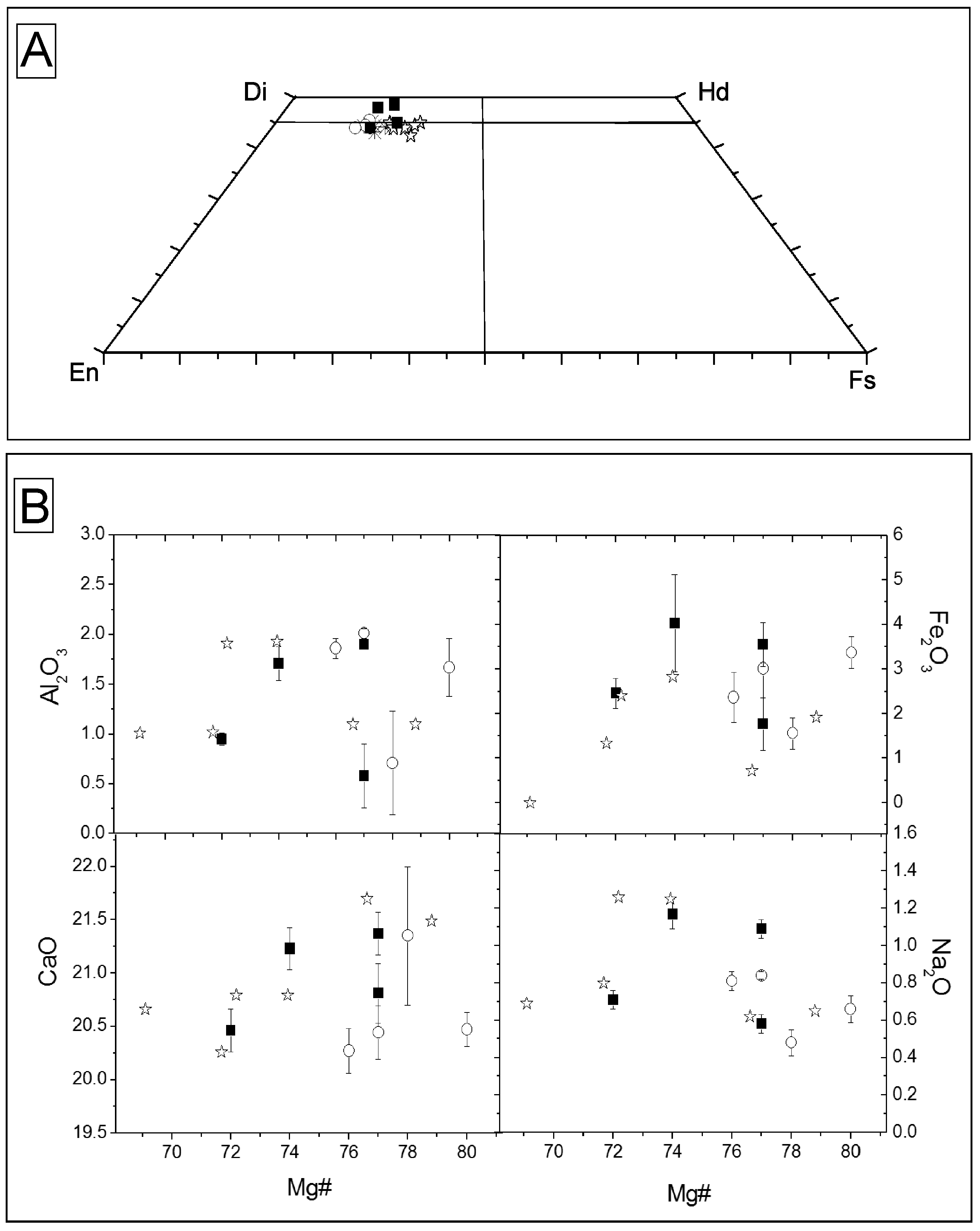

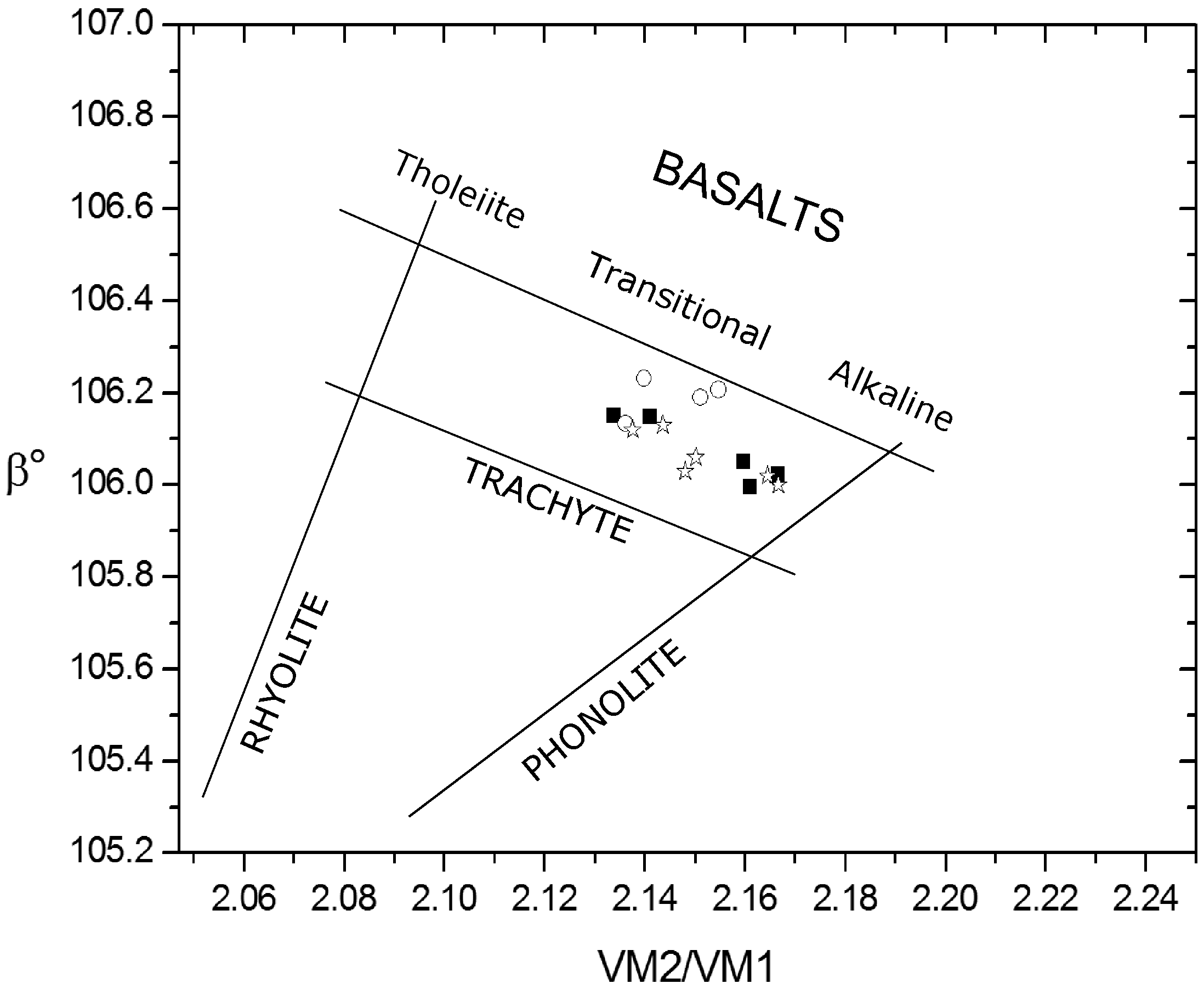
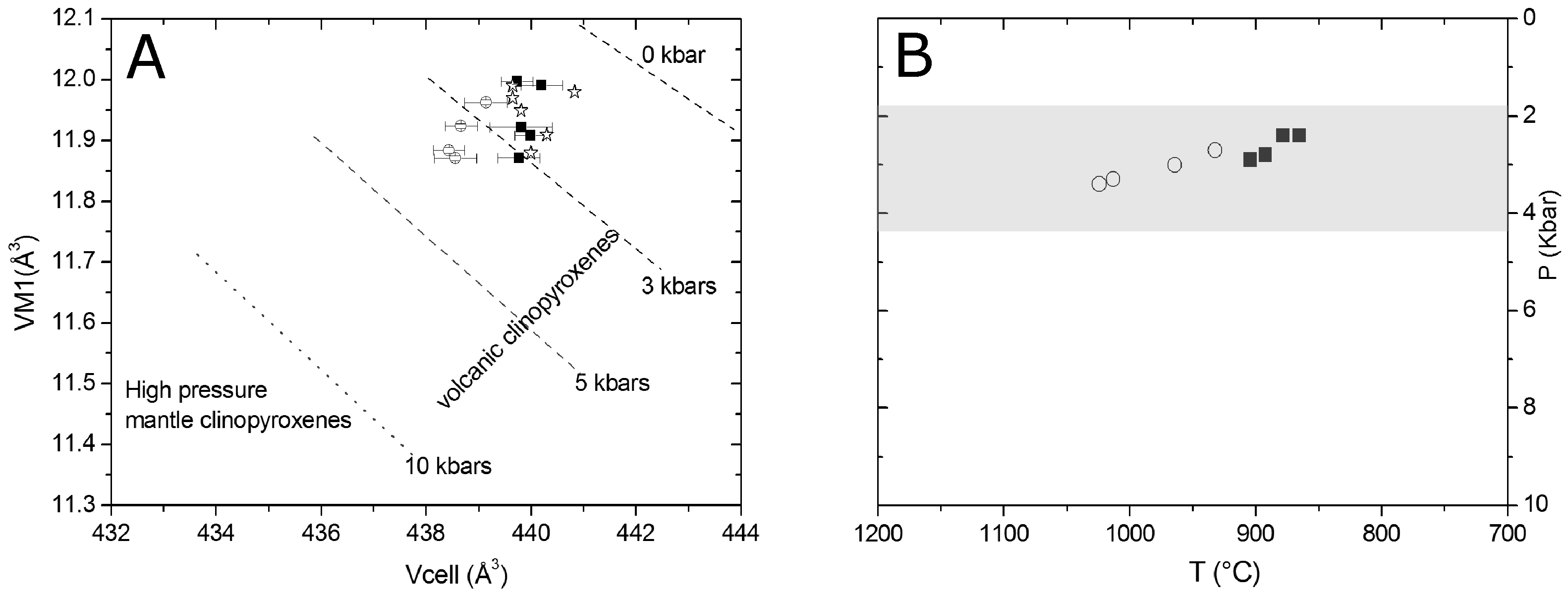
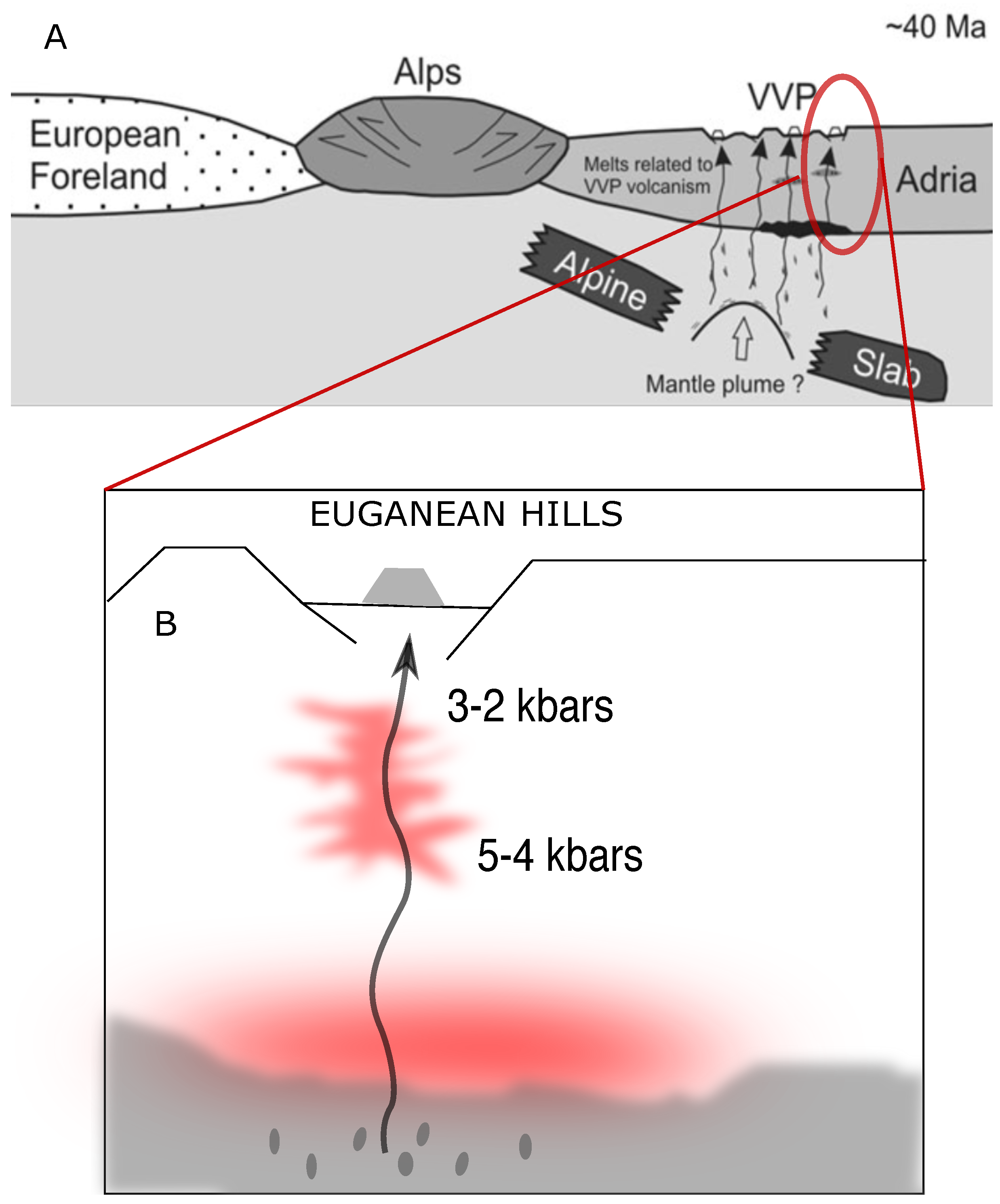
| Sample | CEM6E | CEM6H | CEM15E | CEM15H | CEM18E | CEM18H | CEM33E | CEM33H | CEM33Hb |
|---|---|---|---|---|---|---|---|---|---|
| Sample | Enclave | Host | Enclave | Host | Enclave | Host | Enclave | Host | Host |
| a | 9.740(6) | 9.751(4) | 9.742(5) | 9.749(5) | 9.747(5) | 9.751(7) | 9.7445(4) | 9.751(4) | 9.755(5) |
| b | 8.916(5) | 8.923(3) | 8.916(4) | 8.918(5) | 8.928(4) | 8.921(4) | 8.920(3) | 8.933(3) | 8.929(4) |
| c | 5.257(4) | 5.261(2) | 5.258(3) | 5.262(4) | 5.253(3) | 5.259(4) | 5.256(2) | 5.256(3) | 5.262(3) |
| 106.19(3) | 106.05(3) | 106.21(4) | 106.02(3) | 106.13(4) | 106.0(6) | 106.23(3) | 106.15(3) | 106.15(4) | |
| V | 438.4 | 438.9(3) | 438.6(4) | 439.8(4) | 439.1(4) | 439.8(6) | 438.7(3) | 439.7(3) | 440.2(4) |
| Rint | 1.8 | 2.6 | 2.4 | 1.7 | 2.2 | 3.6 | 2.2 | 2.3 | 5.1 |
| R1 | 2.6 | 2.3 | 2.2 | 2.1 | 2.3 | 2.6 | 2.5 | 2.3 | 5.3 |
| 2 max | 62 | 62 | 62 | 62 | 62 | 62 | 62 | 62 | 64 |
| Goof | 1.25 | 1.14 | 1.22 | 1.26 | 1.26 | 1.24 | 1.16 | 1.29 | 1.085 |
| T-O2 | 1.589(2) | 1.591(2) | 1.592(2) | 1.592(2) | 1.590(2) | 1.590(2) | 1.593(1) | 1.590(2) | 1.595(1) |
| T-O1 | 1.607(2) | 1.607(2) | 1.611(2) | 1.610(2) | 1.604(2) | 1.608(2) | 1.607(2) | 1.605(2) | 1.610(1) |
| T-O3 | 1.662(2) | 1.665(2) | 1.662(2) | 1.665(1) | 1.664(2) | 1.664(2) | 1.664(1) | 1.661(2) | 1.666(1) |
| T-O3 | 1.679(2) | 1.679(2) | 1.680(2) | 1.682(1) | 1.680(2) | 1.681(2) | 1.679(1) | 1.681(2) | 1.683(1) |
| <T-O> | 1.635(2) | 1.635(2) | 1.636(2) | 1.637(2) | 1.634(2) | 1.636(2) | 1.636(2) | 1.634(2) | 1.639(2) |
| VT | 2.226(2) | 2.227(2) | 2.230(1) | 2.233(1) | 2.224(1) | 2.229(1) | 2.229(1) | 2.223(2) | 2.234(1) |
| 1.0057 | 1.0058 | 1.0056 | 1.0059 | 1.0058 | 1.0057 | 1.0057 | 1.0057 | 1.01 | |
| 24.060 | 24.691 | 23.753 | 25.125 | 24.844 | 24.243 | 24.117 | 24.394 | 24.65 | |
| M1-O2 | 2.045(2) | 2.043(1) | 2.042(2) | 2.039(1) | 2.049(2) | 2.044(2) | 2.045(1) | 2.050(2) | 2.046(1) |
| M1-O1 | 2.061(2) | 2.068(2) | 2.061(2) | 2.066(2) | 2.065(2) | 2.067(2) | 2.062(2) | 2.069(2) | 2.066(1) |
| M1-O1 | 2.132(2) | 2.131(1) | 2.130(2) | 2.130(1) | 2.135(2) | 2.130(2) | 2.134(1) | 2.136(2) | 2.137(1) |
| <M1-O> | 2.078(2) | 2.081(1) | 2.078(2) | 2.082(2) | 2.083(2) | 2.080(2) | 2.080(2) | 2.085(2) | 2.084(2) |
| VM1 | 11.881(5) | 11.916(4) | 11.869(2) | 11.873(1) | 11.964(3) | 11.912(3) | 11.918(3) | 11.997(3) | 11.970(3) |
| 1.0055 | 1.0056 | 1.0056 | 1.0057 | 1.0052 | 1.0056 | 1.0053 | 1.0052 | 1.0052 | |
| 17.350 | 17.963 | 17.608 | 18.264 | 16.540 | 17.942 | 16.706 | 16.513 | 16.468 | |
| M2-O2 | 2.311(2) | 2.329(2) | 2.312(2) | 2.332(2) | 2.305(2) | 2.332(2) | 2.301(2) | 2.305(2) | 2.306(1) |
| M2-O1 | 2.346(2) | 2.358(2) | 2.346(2) | 2.358(2) | 2.344(2) | 2.355(2) | 2.341(1) | 2.344(2) | 2.344(1) |
| M2-O3 | 2.578(2) | 2.569(2) | 2.577(2) | 2.566(2) | 2.588(2) | 2.569(2) | 2.587(2) | 2.588(2) | 2.589(1) |
| M2-O3 | 2.740(2) | 2.738(2) | 2.742(2) | 2.735(2) | 2.739(2) | 2.737(2) | 2.741(2) | 2.745(2) | 2.740(1) |
| <M2-O> | 2.494(2) | 2.498(2) | 2.494(2) | 2.473(2) | 2.494(2) | 2.498(2) | 2.492(2) | 2.495(2) | 2.496(2) |
| VM2 | 25.558(8) | 25.737(7) | 25.576(5) | 25.725(6) | 25.557(4) | 25.741(6) | 25.502(5) | 25.599(5) | 25.629(5) |
| Sample | CEM6E | CEM6H | CEM15E | CEM15H | CEM18E | CEM18H | CEM33E | CEM33H |
|---|---|---|---|---|---|---|---|---|
| Sample | Enclave | Host | Enclave | Host | Enclave | Host | Enclave | Host |
| SiO | 53.21(62) | 52.43(37) | 51.99(47) | 51.92(60) | 52.02(48) | 53.36(54) | 52.33(22) | 51.64(31) |
| TiO | 0.26(7) | 0.30(4) | 0.38(7) | 0.33(2) | 0.29(8) | 0.25(11) | 0.26(5) | 0.45(9) |
| AlO | 0.58(32) | 1.86(10) | 1.90(4) | 2.01(5) | 1.71(17) | 0.71(52) | 0.95(6) | 1.67(29) |
| CrO | - | 0.01(1) | 0.02(1) | 0.02(2) | - | 0.01(2) | - | 0.03(3) |
| FeO | 9.43(0.25) | 9.89(013) | 10.03(27) | 9.87(20) | 11.20(41) | 8.92(35) | 11.30(86) | 9.58(31) |
| MnO | 1.29(7) | 0.47(5) | 0.89(4) | 0.74(3) | 1.07(9) | 0.52(6) | 1.21(7) | 0.59(11) |
| MgO | 14.37(28) | 14.04(18) | 12.54(23) | 1 3.67(7) | 11.87(19) | 14.92(14) | 12.92(43) | 14.85(20) |
| CaO | 20.81(28) | 20.27(21) | 21.37(20) | 20.44(25) | 21.23(20) | 21.35(65) | 20.46(20) | 20.47(16) |
| NaO | 0.58(5) | 0.81(5) | 1.09(5) | 0.84(2) | 1.17(8) | 0.48(7) | 0.71(5) | 0.66(7) |
| Oxide total | 100.53(40) | 100.09(63) | 100.20(84) | 99.84(88) | 100.57(70) | 100.52(56) | 100.12(41) | 99.92(41) |
| FeO | 1.77(59) | 2.37(56) | 3.55(49) | 3.01(65) | 4.03(1.09) | 1.56(35) | 2.46(34) | 3.37(35) |
| FeO | 7.84(0.56) | 7.76(46) | 6.84(32) | 7.17(54) | 7.58(85) | 7.51(5) | 9.08(95) | 6.55(51) |
| Total | 100.71(37) | 100.32(65) | 100.56(86) | 100.14(86) | 100.97(71) | 100.68(57) | 100.37(41) | 100.25(43) |
| Si | 1.974(17) | 1.947(8) | 1.937(8) | 1.935(9) | 1.940(17) | 1.971(16) | 1.962(6) | 1.920(13) |
| Ti | 0.007(2) | 0.009(1) | 0.011(2) | 0.009(1) | 0.008(2) | 0.007(3) | 0.007(2) | 0.013(2) |
| Al | 0.025(14) | 0.081(4) | 0.083(1) | 0.088(2) | 0.075(8) | 0.031(23) | 0.042(2) | 0.073(12) |
| Cr | - | - | - | 0.001((1) | - | - | - | 0.001(1) |
| Fe | 0.050(17) | 0.066(15) | 0.100(14) | 0.084(18) | 0.113(30) | 0.043(10) | 0.070(9) | 0.094(9) |
| Fe | 0.243(16) | 0.241(15) | 0.213(11) | 0.223(16) | 0.237(26) | 0.232(3) | 0.285(30) | 0.204(16) |
| Mn | 0.041(2) | 0.015(2) | 0.028(2) | 0.023(1) | 0.034(2) | 0.016(2) | 0.038(3) | 0.019(4) |
| Mg | 0.795(14) | 0.777(7) | 0.697(8) | 0.759(4) | 0.660(12) | 0.822(5) | 0.722(24) | 0.823(10) |
| Ca | 0.827(13) | 0.806(5) | 0.853(1) | 0.816(6) | 0.848(6) | 0.845(24) | 0.822(8) | 0.815(6) |
| Na | 0.041(4) | 0.058(3) | 0.078(3) | 0.061(1) | 0.085(6) | 0.035(5) | 0.051(4) | 0.047(5) |
| Mg No | 77 | 76 | 77 | 77 | 74 | 78 | 72 | 80 |
| Wollastonite | 44 | 44 | 48 | 45 | 49 | 44 | 45 | 44 |
| Enstatite | 43 | 43 | 40 | 42 | 38 | 43 | 39 | 45 |
| Ferrosilite | 13 | 13 | 12 | 12 | 14 | 12 | 16 | 11 |
| Sample | CEM18E | CEM15E | CEM33E | CEM6E | CEM15H | CEM33H |
|---|---|---|---|---|---|---|
| Sc | 32.31(1.41) | 92.20 (2.35) | 122.77(2.00) | 95.25(5.00) | 180.708(3.90) | 251.20(2.80) |
| Ti | 1265(60) | 1963(48) | 2682(40) | 1158(49) | 2455(84) | 1279(24) |
| V | 65.00(4.23) | 78.20(2.43) | 86.47(1.77) | 36.75(2.35) | 78.40(2.30) | 33.05(0.87) |
| Cr | 4.50(8.30) | 1.60(5.25) | 5.10(4.53) | 3.40(7.35) | 0.40(4.40) | 1.10(2.90) |
| Mn | 3940(207) | 5855(172) | 4380(115) | 8455(290) | 7480(160) | 10040(175) |
| Co | 38.40(2.77) | 23.25(1.11) | 21.45(84) | 25.00(1.15) | 15.10(88) | 9.51(53) |
| Cu | 0.50(1.28) | 0.77(1.01) | 0.12(73) | 0.95(1.55) | 0.60(82) | bdl |
| Ga | 5.66(78) | 11.48(1.04) | 9.58(76) | 6.42(67) | 13.02(94) | 7.65(60) |
| Rb | 0.01(24) | 0.18(26) | 0.29(24) | 0.26(48) | 0.12(19) | bdl |
| Sr | 13.20(98) | 41.10(1.40) | 41.35(97) | 5.19(90) | 12.61(61) | 3.31(20) |
| Y | 82.80(5.00) | 87.13(2.43) | 93.67(1.57) | 167.05(7.40) | 77.60(2.30) | 135.40(2.05) |
| Zr | 40.53(2.23) | 120.60(3.15) | 155.43(2.73) | 50.10(4.65) | 164.10(6.00) | 84.40(1.70) |
| Nb | 0.520(136) | 0.707(175) | 0.424(115) | 0.790(225) | 1.650(230) | 0.319(91) |
| Sn | 1.993(770) | 2.635(387) | 1.720(270) | 2.765(685) | 5.940(590) | 1.920(270) |
| Cs | 0.0220(563) | 0.0340(320) | 0.0050(327) | 0.0500(705) | bdl | 0.0010(275) |
| Ba | 0.120(197) | 0.070(0.133) | 0.190(187) | 0.445(370) | 0.050(160) | 0.075(150) |
| La | 23.753(1.470) | 20.355(690) | 17.920(477) | 55.800(4.050) | 34.510(0.700) | 34.060(0.690) |
| Ce | 91.70(4.83) | 74.10(1.75) | 69.00(1.23) | 204.50(15.50) | 122.70(2.80) | 134.50(1.90) |
| Pr | 16.030(967) | 13.030(492) | 12.673(350) | 3.70(2.80) | 19.48(49) | 24.045(485) |
| Nd | 80.20(5.10) | 69.775(2.900) | 72.167(1.900) | 169.50(12.50) | 98.00(3.00) | 129.35(2.75) |
| Sm | 23.767(3.167) | 22.475(1.475) | 23.680(1.093) | 48.550(3.700) | 26.80(1.80) | 39.25(1.35) |
| Eu | 3.333(343) | 5.415(420) | 5.840(263) | 3.350(425) | 4.830(310) | 4.345(235) |
| Gd | 22.100(2.333) | 22.45(1.70) | 24.17(1.10) | 46.80(4.55) | 22.00(1.30) | 37.25(1.25) |
| Tb | 3.140(317) | 3.312(222) | 3.683(167) | 6.930(545) | 3.350(220) | 5.580(175) |
| Dy | 20.13(1.80) | 20.72(1.14) | 22.57(76) | 37.70(2.70) | 20.10(1.00) | 33.06(88) |
| Ho | 3.430(337) | 3.607(217) | 3.803(160) | 6.320(565) | 3.340(190) | 5.830(190) |
| Er | 8.660(927) | 9.245(565) | 10.027(440) | 16.090(1.210) | 8.050(530) | 14.450(5359 |
| Tm | 1.163(167) | 1.260(130) | 1.329(94) | 2.045(255) | 1.090(120) | 1.810(107) |
| Yb | 7.097(967) | 7.420(687) | 7.893(517) | 12.450(1.450) | 6.890(680) | 11.425(615) |
| Lu | 0.850(153) | 0.964(114) | 1.051(82) | 1.620(190) | 0.980(120) | 1.635(100) |
| Hf | 2.270(357) | 5.747(480) | 5.550(363) | 3.335(610) | 8.150(580) | 3.145(230) |
| Ta | 0.0347(267) | 0.0963(333) | 0.0413(163) | 0.0700(470) | 0.2720(580) | 0.0310(135) |
| Pb | 0.337(180) | 0.315(135) | 0.263(130) | 0.580(325) | 0.540(140) | 0.500(145) |
| Th | 0.503(77) | 0.174(50) | 0.095(25) | 0.366(123) | 0.153(38) | 0.054(17) |
| U | 0.071(40) | 0.023(16) | 0.013(8) | 0.083(56) | bdl | 0.0053(56) |
| Sample | T (°C) | P (kbar) |
|---|---|---|
| CEM6H | 904 | 2.9 |
| CEM6E | 1024 | 3.4 |
| CEM15H | 892 | 2.8 |
| CEM15E | 932 | 2.7 |
| CEM18H | 865 | 2.4 |
| CEM18E | 964 | 3.0 |
| CEM33H | 878 | 2.4 |
| CEM33E | 1013 | 3.3 |
Publisher’s Note: MDPI stays neutral with regard to jurisdictional claims in published maps and institutional affiliations. |
© 2022 by the authors. Licensee MDPI, Basel, Switzerland. This article is an open access article distributed under the terms and conditions of the Creative Commons Attribution (CC BY) license (https://creativecommons.org/licenses/by/4.0/).
Share and Cite
Nazzareni, S.; Morgavi, D.; Petrelli, M.; Bartoli, O.; Perugini, D. Magmatic Processes at Euganean Hills (Veneto Volcanic Province, Italy): Clinopyroxene Investigation to Unravel Magmatic Interactions. Geosciences 2022, 12, 108. https://doi.org/10.3390/geosciences12030108
Nazzareni S, Morgavi D, Petrelli M, Bartoli O, Perugini D. Magmatic Processes at Euganean Hills (Veneto Volcanic Province, Italy): Clinopyroxene Investigation to Unravel Magmatic Interactions. Geosciences. 2022; 12(3):108. https://doi.org/10.3390/geosciences12030108
Chicago/Turabian StyleNazzareni, Sabrina, Daniele Morgavi, Maurizio Petrelli, Omar Bartoli, and Diego Perugini. 2022. "Magmatic Processes at Euganean Hills (Veneto Volcanic Province, Italy): Clinopyroxene Investigation to Unravel Magmatic Interactions" Geosciences 12, no. 3: 108. https://doi.org/10.3390/geosciences12030108
APA StyleNazzareni, S., Morgavi, D., Petrelli, M., Bartoli, O., & Perugini, D. (2022). Magmatic Processes at Euganean Hills (Veneto Volcanic Province, Italy): Clinopyroxene Investigation to Unravel Magmatic Interactions. Geosciences, 12(3), 108. https://doi.org/10.3390/geosciences12030108






